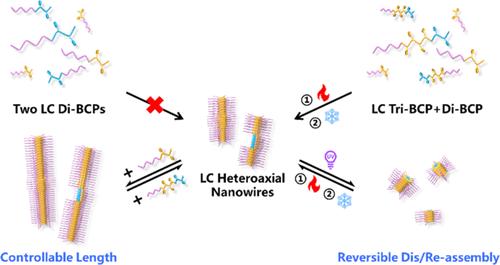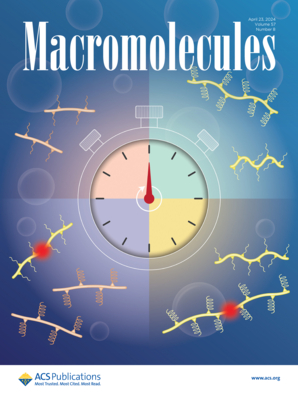One-Pot Heteroepitaxial Living Growth to Liquid Crystalline Block Copolymer Heteroaxial Nanowires and Their Disassembly/Reassembly Behavior
IF 5.1
1区 化学
Q1 POLYMER SCIENCE
引用次数: 0
Abstract
Great efforts have been devoted to studying the self-assembly of block copolymers (BCPs) in solution owing to their vast morphological dispersity and immense potential in biomedicine and nanodevices. Among the assembly processes, the heterogeneous connection has always been a problem to be solved. Moreover, the fabrication of heterogeneous assemblies with advanced functionalities, such as stimulus responsiveness and, particularly, cyclic assembly capabilities, represents a significant challenge in the field. In this work, we propose a novel approach to fabricate heteroaxial nanowires by joining two liquid crystalline (LC) cores using a heteroepitaxial growth strategy via directly mixing two LC BCPs in 1-hexanol and subsequent thermal annealing in one pot. Their formation is affected by the temperatures and compatibilizing segments within the tri-BCP. At the annealing temperature, the tri-BCP with higher aggregation temperatures spontaneously formed nanorod-like micelles as the seeds, while the other di-BCP, which was completely dissolved, served as the growing components. The lengths of the obtained heteroaxial nanowires are controllable and interconvertible by tuning the ratio of seed and growing components, exhibiting living characteristics. Furthermore, these segmented cylindrical micelles can undergo disassembly and reassembly processes via ultraviolet (UV) irradiation and reannealing, respectively. This work provides a valuable example of precisely regulating the structures and functions of heterogeneous assemblies.

求助全文
约1分钟内获得全文
求助全文
来源期刊

Macromolecules
工程技术-高分子科学
CiteScore
9.30
自引率
16.40%
发文量
942
审稿时长
2 months
期刊介绍:
Macromolecules publishes original, fundamental, and impactful research on all aspects of polymer science. Topics of interest include synthesis (e.g., controlled polymerizations, polymerization catalysis, post polymerization modification, new monomer structures and polymer architectures, and polymerization mechanisms/kinetics analysis); phase behavior, thermodynamics, dynamic, and ordering/disordering phenomena (e.g., self-assembly, gelation, crystallization, solution/melt/solid-state characteristics); structure and properties (e.g., mechanical and rheological properties, surface/interfacial characteristics, electronic and transport properties); new state of the art characterization (e.g., spectroscopy, scattering, microscopy, rheology), simulation (e.g., Monte Carlo, molecular dynamics, multi-scale/coarse-grained modeling), and theoretical methods. Renewable/sustainable polymers, polymer networks, responsive polymers, electro-, magneto- and opto-active macromolecules, inorganic polymers, charge-transporting polymers (ion-containing, semiconducting, and conducting), nanostructured polymers, and polymer composites are also of interest. Typical papers published in Macromolecules showcase important and innovative concepts, experimental methods/observations, and theoretical/computational approaches that demonstrate a fundamental advance in the understanding of polymers.
 求助内容:
求助内容: 应助结果提醒方式:
应助结果提醒方式:


